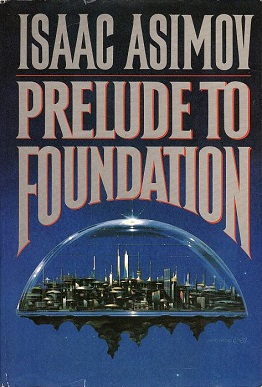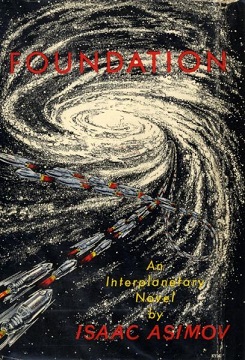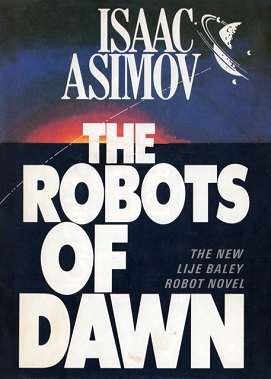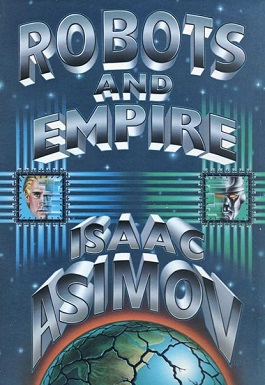
Foundation's Edge (1982)ù is a science fiction novel by American writer Isaac Asimov, the fourth book in the Foundation Series. It was written more than thirty years after the stories of the original Foundation trilogy, due to years of pressure by fans and editors on Asimov to write another, and, according to Asimov himself, the amount of the payment offered by the publisher. It was his first novel to ever land on The New York Times best-seller list, after 262 books and 44 years of writing.

The Caves of Steel is a science fiction novel by American writer Isaac Asimov. It is a detective story and illustrates an idea Asimov advocated, that science fiction can be applied to any literary genre, rather than just being a limited genre in itself.

Prelude to Foundation is a novel by American writer Isaac Asimov, published in 1988. It is one of two prequels to the Foundation series. For the first time, Asimov chronicles the fictional life of Hari Seldon, the man who invented psychohistory and the intellectual hero of the series. The novel was nominated for the Locus Award.

The Foundation series is a science fiction book series written by American author Isaac Asimov. First published as a series of short stories and novellas in 1942–50, and subsequently in three collections in 1951–53, for nearly thirty years the series was a trilogy: Foundation (1951); Foundation and Empire (1952); and Second Foundation (1953). It won the one-time Hugo Award for "Best All-Time Series" in 1966. Asimov later added new volumes, with two sequels: Foundation's Edge (1982) and Foundation and Earth (1986), and two prequels: Prelude to Foundation (1988) and Forward the Foundation (1993).

The Robot Series is a series of thirty-seven science fiction short stories and six novels created by American writer Isaac Asimov, from 1940 to 1995. The series is set in a world where sentient positronic robots serve a number of purposes in society. To ensure their loyalty, the Three Laws of Robotics are programmed into these robots, with the intent of preventing them from ever becoming a danger to humanity. Later, Asimov would merge the Robot series with his Foundation series.
The Galactic Empire series is a science fiction sequence of three of Isaac Asimov's earliest novels, and extended by one short story. They are connected by their early place in his published works and chronological placement within his overarching Foundation universe, set around the rise of Asimov's Galactic Empire, between the Robot and Foundation series to which they were linked in Asimov's later novels.

The Three Laws of Robotics are a set of rules devised by science fiction author Isaac Asimov, which were to be followed by robots in several of his stories. The rules were introduced in his 1942 short story "Runaround", although similar restrictions had been implied in earlier stories.

Nemesis is a science fiction novel by American writer Isaac Asimov. One of his later science fiction novels, it was published in 1989, three years before his death. The novel is loosely related to the future history of his Robot Series, Empire Series, and Foundation Series, into which Asimov attempted to integrate his science fiction output. This novel is connected to Asimov's other works by several ideas from earlier and later novels, including non-human intelligence, sentient astronomical bodies ("Hallucination"), and rotor engines.

Pebble in the Sky is a science fiction novel by American writer Isaac Asimov, published in 1950. This work is his first novel — parts of the Foundation series had appeared from 1942 onwards in magazines, but Foundation was not published in book form until 1951. The original Foundation books are also a string of linked episodes, whereas this is a complete story involving a single group of characters.

R. Daneel Olivaw is a fictional robot created by Isaac Asimov. The "R" initial in his name stands for "Robot," a naming convention in Asimov's future society during Earth's early period of space colonization. Daneel is introduced in The Caves of Steel, a serialized story published in Galaxy Science Fiction from October to December 1953. The full story was published by Doubleday as a hardcover book in 1954.

Robots and Empire is a science fiction novel by the American author Isaac Asimov, published by Doubleday Books in 1985. It is part of Asimov's Robot series, which consists of many short stories and five novels.

The Naked Sun is a science fiction novel by American writer Isaac Asimov, the second in his Robot series. Like its predecessor, The Caves of Steel, this is a whodunit story. It was first published in book form in 1957 after being serialized in Astounding Science Fiction between October and December 1956.

The Robots of Dawn is a "whodunit" science fiction novel by American writer Isaac Asimov, first published in 1983. It is the third novel in Asimov's Robot series.

Elijah "Lije" Baley is a fictional character in Isaac Asimov's Robot series. He is the main character of the novels The Caves of Steel, The Naked Sun and The Robots of Dawn, and of the short story "Mirror Image." He is seen in flashbacks several times and talked about frequently in Robots and Empire, which is set roughly 160 years after his death. He is further mentioned in passing in "Foundation and Earth" as a "Culture Hero". Besides Asimov's works he appears in the Foundation's Friends story "Strip-Runner" by Pamela Sargent, and "Isaac Asimov's 'The Caves of Steel'" poem by Randall Garrett.

Foundation and Chaos (1998) is a science fiction novel by Greg Bear, set in Isaac Asimov's Foundation universe. It is the second book of the Second Foundation trilogy, which was written after Asimov's death by three authors, authorized by the Asimov estate.

Foundation's Triumph (1999) is a science fiction novel by American writer David Brin, set in Isaac Asimov's Foundation universe. It is the third book of the Second Foundation trilogy, which was written after Asimov's death by three authors, authorized by the Asimov estate. Brin synthesizes dozens of Foundation-Empire-Robots novels and short stories by Isaac Asimov, Roger MacBride Allen, and authorized others into a consistent framework. Foundation's Triumph includes an appendix chronology compiled by Attila Torkos.
Psychohistory is a fictional science in Isaac Asimov's Foundation universe which combines history, sociology, and mathematical statistics to make general predictions about the future behavior of very large groups of people, such as the Galactic Empire. It was first introduced in the four short stories (1942–1944) which would later be collected as the 1951 novel Foundation.
The Foundation universe is the future history of humanity's colonization of the galaxy, spanning nearly 25,000 years, created through the gradual fusion of the Robot, Galactic Empire, and Foundation book series written by American author Isaac Asimov.

Demerzel is a fictional character in the 2021 Apple TV+ television series Foundation, an adaptation of the Foundation series of novels by Isaac Asimov. She is portrayed by Finnish actress Laura Birn. Demerzel is a gynoid, or female-presenting humanoid robot, who serves as the majordomo to the revolving trio of Emperor Cleon clones, Brothers Dawn, Day and Dusk. In season two, it is revealed that Demerzel is the real power behind the Imperial throne, guiding humanity on a millennial scale.














